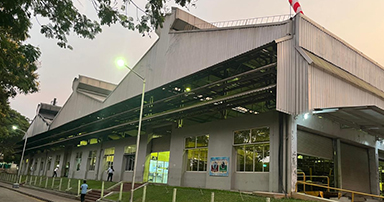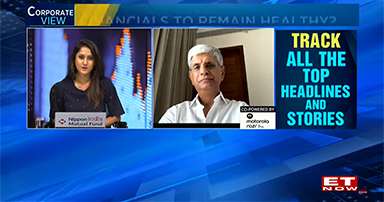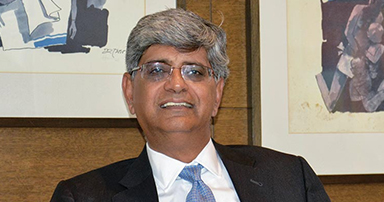
Some major changes in the auto industry over the next five to 10 years will throw up a good number of opportunities for component suppliers. Sandhar Technologies, among others, has taken new steps to take its 31-year-old story forward. 2018 was a milestone year as it took multiple inorganic steps to tap opportunities across new product lines and also got listed on the bourses. For leading his venture successfully and mainly for the new moves, some of which are aimed at tapping megatrends, Jayant Davar, founder, co-chairman and managing director of Sandhar Technologies, is Autocar Professional's Man of the Year 2018. Sumantra B Barooah brings more details.

It's after 7:30 in the evening. Anyone who has had five to six business meetings during the day is likely to feel tired by this time. Jayant Davar, 57, doesn't look or sound tired. Maybe it's the drive that entrepreneurs who work with passion and growing ambitions enjoy. Maybe, the cup of green tea also helped in getting refreshed. The Sandhar Technologies (earlier known as Sandhar Locking Devices) story, which began in 1987, is interesting. The entrepreneurship bug bit Davar soon after he earned his engineering degree. What makes it more interesting is that Davar's journey began with loans of Rs 30,000 from his father and around Rs 400,000 from the State Bank of India. He has been venturing into new areas to grow the company both vertically and laterally. That seems to have yielded good results. From a turnover of Rs 12.5 lakh in its first year of operations, Sandhar Technologies ended the last financial year (FY2018) with a turnover of around Rs 1,900 crore. This financial year (FY2019) Sandhar Technologies' revenue could climb up to around Rs 2,500 crore. A significant part of it will come from new product lines set to be launched in 2019, for which the company has tied up with foreign partners. Notably, six of the eight joint ventures (JV) that Sandhar Technologies currently has were signed in 2017 and 2018. The series of partnerships were led by the company's key strategy to increase the wallet share of business from customers. From helmets to fuel pumps, oil filters, starter motors to electric vehicle (EV) components, a host of new products will be launched in 2019. "It is going to be able to strengthen our sustainable growth management width. It will need a lot of training and education to the teams. It will need absorbing of new technologies that are coming in," says Davar. With so many new product lines getting launched almost simultaneously, the first challenge for Davar and his team will be their stabilisation. We learn that Sandhar Technologies is in talks with another company for yet another alliance, but Davar would not comment on that at this stage. Sandhar Technologies' strategy is to tap the business opportunities that are growing due to new regulations and global megatrends of electric mobility, autonomous driving, shared mobility and connected vehicles. "We need to be in tandem with what the industry is looking for or what the sector is looking for," says Davar. Over the past five years, the company has invested Rs 650 crore to also prepare itself for the future. The technocrat promoter identified sectors that are promising and technologies that will help his company be ahead of the curve. Financial borrowings grew and debt level was on the rise as returns on some of the investments were still some time away. At one point, Sandhar Technologies was investing Rs 100 crore in capital expenditure and spending another Rs 100 crore in loan servicing cost. The "double whammy" was taking a toll. That led to Davar decide to tap the bourses by becoming a publicly listed company and repay all debts. April 2 will remain a red-letter day for Sandhar Technologies as it debuted in the bourses with a share price of Rs 349 apiece. The Rs 512-crore IPO received bids for 6.73 crore equity shares. The issue size was 1.08 crore shares. It wasn't the best of time to get listed but Davar says, "Suffice it to say that we got an excellent response when we listed and the investors gave us a great response. Our scrip has done quite well. It has shown the premiums that many others on the launch did not. We were lucky to get through very well." Life hasn't changed for the entrepreneur except that he has to be much more prudent in taking business decisions, especially financial.
TARGET POLE POSITION
India is the world's largest two-wheeler market, India's Hero MotoCorp is the world's largest two-wheeler manufacturer, but not many would know that home-grown Sandhar Technologies is the world's largest manufacturer of two-wheeler locks. Currently, it produces over 100,000 lock sets daily! Not surprising also as this maiden business of the company started with Hero MotoCorp (then known as Hero Honda). The locking systems business contributes to nearly 20 percent of Sandhar Technologies' revenue. Seatbelt spool is another product where Sandhar Technologies rules the roost. With a 28 percent share of the world market, the company is the world's largest manufacturer of spools. This business was inherited through an acquisition in 2007 of Tecfisa, a Spanish company specialising in aluminium die casting and mould design. Along with the technology came customers like Autoliv and Bosch through this acquisition. With the host of new businesses, Sandhar Technologies wants to be the lead player in each one. An ambition easier said than done one would say, but Davar is clear about his target. "If we are entering any business, it is with a clear mind of being the best in our business in terms of volume. If it's helmets, we want to be the best and the biggest helmet manufacturer in the world. That is the target. That is how these products are picked. That has been our history and that is how we want to carry it into the future," he says.

Technology is a key decision driver in spending money for Davar, who is an engineer and would rather depend on the company's CFO for financials. "We have invested in new plastic moulding facilities, zinc die-casting facilities, magnesium casting, which is new to India and all of these componentry will come out of Sandhar into the joint ventures as aggregates and will be used for assemblies. So there is a backward integration as well which keeps moving. We set up a new facility in Jaipur last year. We just bought land to set up another much bigger facility in Jaipur. So there is a lot of expansion that has gone into and now is the time when we start," says Davar. Cabins is another business on which Davar is quite bullish. Sandhar Technologies entered this segment in 2012 by acquiring Bangalore-based Mag Engineering, a specialist in sheet metal fabrication for industrial requirements. It was followed by another acquisition of Pune-based Arkay Fabsteel Systems. The cabins business is likely to earn Rs 350 crore for the company this year. Davar foresees "huge potential" to scale up this business as he plans to expand into the farm tractor segment after the construction equipment market. "There is a mandate that high-end tractors will carry cabins. We have already started supplies to tractors but it is still small. Gradually, it will become the order of the day," says Davar. With India the world's largest tractor market and also home to the world's largest tractor maker Mahindra, Sandhar could well become the largest cabin maker in the world

NEW INNINGS
As the highly unorganised Indian aftermarket begins to get organised, interest is on the rise for new players. One among them is Sandhar Technologies. Many of its new product lines like starter motors, filters and primarily helmets will be aimed at the aftermarket. A successful play here could lead to big gains. According to a study commissioned by the Confederation of Indian Industry (CII), the Indian aftermarket is projected to reach the Rs 75,000 crore market. In FY2018, it clocked sales of Rs 61,601 crore, up nine percent YoY. Davar and his team are now mulling over activities like branding, marketing and celebrity endorsement which the company has never done earlier. "I think we will need to build the management bandwidths to be able to handle that. We have 9,000 employees. With the rate of growth that we are looking at, those numbers will become higher," says Davar.

MULTIPLE ROUTES TO GROWTH
Low-cost, high-scale manufacturing has been the forte of Indian companies. There have been a spate of efforts by home-grown players to enhance their technological capabilities and also bag new customers. For building technological competence, Sandhar Technologies has taken the routes of technical arrangement, technical collaboration, JVs and acquisitions with 15 companies. Through JVs with companies like Kwangsung of South Korea and Whetron of China, Sandhar Technologies is looking to tap the opportunities presented by growing megatrends of electric mobility and autonomous vehicles. When the Sandhar Technologies journey started as Sandhar Locking Devices on October 19, 1987, Jayant Davar had one big dream — to achieve a turnover of Rs 1 crore. Some may say it was a dream not big enough. But for a 24-yearold, first-generation entrepreneur from a middle-class background, it was indeed a big dream. It's a different story that the ambition was achieved in the company's third year of operations. Since then till now, when the company is driving towards the Rs 2,500 crore mark, Sandhar Technologies been a good case study of the Indian entrepreneurial spirit, a growing number of them seen in the component industry. A CAGR of 32 percent over 30 years is impressive. At that rate a Rs 10,000 crore turnover shouldn't be too far away. "So, when do you expect to cross that milestone?" I ask Davar. "Unfortunately, I am not at liberty to answer that question, but suffice it to say we have grown faster than the industry," he says, now much more careful with his investments, and with his words as the MD of a listed company.
Interview Jayant Davar, founder, co-chairman and managing Director, Sandhar Technologies

You are a past president of ACMA and an industry player. How would you rate the Indian component industry especially in the parameters of innovation, quality, technology and fiscal performance as of date?
The automotive industry started in India in its true represented form 35 years ago. Since then, we have made some amazing progress. Today, India exports a significant amount of its output to every corner of the globe and to every car manufacturer. Whether it is a Mercedes, Toyota, Suzuki, Honda, or any other make that is made in India, it is of the same category and same calibre as sold anywhere else in the world. India’s component industry has the highest number of Deming Prize winners outside of Japan and that comes from a huge metamorphosis in quality and management systems. Yes, we do lack in several areas, innovation and R&D for example, but then we have to look at the history. When the Japanese came in, it was a print-to-manufacture industry. They gave us prints and we learnt how to manufacture it and we did. We did not get an opportunity to really develop things on our own. In fact, the first time that India produced something (fully) indigenous was the Tata Nano. That was the first time when people were given an opportunity to design things on a black-box basis. While the Nano did not do that well, I think it did change the aspect of the industry. I would think that there is not a single big or medium-sized manufacturer who today does not have a significant R&D centre, who's not into design capabilities in a proper fashion. All that is happening but yet the amount that we spent of our revenue compared to some of our best peers is very small (for R&D). We also don’t have an ecosystem of R&D in the country. If you look at pure numbers, I understand there are almost 1.71.8 million engineers who are produced in the country (every year). The ones who go in for post-graduate programmes are only a bare percentage of the whole and those for doctoral programmes even fewer. And of those who go into R&D are only a handful, and even those want to go into government bodies. People who are left for (industry) R&D are very few and far between. To generate that ecosystem of research is extremely important and I think the government needs to get in there, the mindset of people has to change. That is why you will see in our automotive industry, a lot of technology is coming in from outside rather than being developed here. But it is changing, gradually but surely. I think in another 10 years, with a young population, we would have a distinctive advantage.
The employability of engineers has been an issue for long. What steps should be taken to bridge the skill gap, and address the challenge the auto industry faces?
One has been talking with the government. We need to build a very strong ecosystem. You need all the stakeholders to be at par, which means you need the industry, the academia, the government. All three need to come together, which means the curriculum has to be designed according to what the industry wants (industry consultation). The R&D that has to be carried out has to be based on what the industry wants, then the academia works on it with the professors and chairs and students to get that. The government has to provide a taxcompliant policy to help people build that ecosystem. You know all of that has to work together. Unfortunately we are working in silos. Therefore, the curriculum, which was designed a long time ago, may or may not be in sync with what the industry wants. If you are going to have a lot of electronics in the industry, then the academia needs to teach it. You need the faculty to teach that and students to understand that. All that will only happen if the government has policies which encourage or motivate for all this to happen.
There are skill gaps in certain areas between Tier 1 and smaller suppliers. How should that be addressed?
I think this has to be addressed very clearly. When you talk of skills, skills is an unending game. It is learning something today, unlearning that tomorrow and relearning something else. Unfortunately, the small scale sector has leadership issues. It could be a proprietor who is the owner, manager, general manager, managing director and the supervisor, all rolled into one. He will always be limited by what he knows at that point of time. He doesn’t have the time to leave that place, go out for training and come back and say that I have learnt something here. So we are very shorthanded with stuff like that. My message always to the small scale sector is that when you hire people, you hire people who are better than you at what they do. If you only want to hire somebody who gives you salaam , then it doesn’t serve the purpose. The mindset has to change. India is a hierarchical society where people like to be salaamed all the time and that culture may or may not do well in the future.
Talking about R&D investments, what is Sandhar Technologies' annual R&D spend?
R&D spend is a combination of factors. It is what goes directly into our R&D centre. It is a lot of process engineering done at different units with different product lines because the manufacturing plants themselves do a lot of it. I won’t be able to give you a direct number because many aspects of this go into revenue expenditure, but I will think it is still below 2 percent of our revenue. We still have a long way to go. But all I can tell you is this 2 percent is now employed very justifiably and with the right outcomes and rewards, which was not the case earlier.
Results of many of the steps taken by Sandhar Technologies this year will bear fruit from 2019. How is the mid- to longterm picture looking for the company?
We need to be in tandem with what the industry or sector is looking for. We have often spoken about several aspects of the game — about autonomous vehicles, connected vehicles, shared mobility, electric or other kind of green vehicles. If you want to put so many things together, there are still huge things in the arena which could be looked at. Every new product line is built for the future, so we entered 1987 with locks. While we may be far ahead of anyone else, we will continue in that direction. Each new product line has a huge mass potential going forward. 2018-19 will see the launch of many such product lines and each one is there to grow. Our aspiration, obviously, is to be the best in what we do, whether it be in volumes, quality or competitiveness.
Do you see any of the product lines getting the scale and the stature of being the top rung?
Absolutely, each one. If we are entering any business, it is with a clear mind of being the best in our business in terms of volume. If it's helmets, we want to be the best and the biggest helmet manufacturer in the world. Suffice it to say that we want to be in leadership position in each product line. That is the target. That is how these products are picked. That has been our history and that is how we want to carry it into the future.

Are you adopting Industry 4.0 in Sandhar?
We have taken a lead in doing that. We believe that it is the future. You'll make it cheaper because the rejections would be fewer and productivity much better. Manpower can be employed for other things rather than pure basic manufacturing. Why would they do it when the investments are small? Today computers are a part of everyday life. And all we talk about industry 4.0 is connected manufacturing. Professor Dan Jones of the Lean Institute had once said that if you were to do value mapping, you would see the amount of time, effort and energy that is wasted in between idle times. If you are connected, you won’t have idle times. You can save a lot of resources and make your time much more productive if you use systems that available. All you have to do is connect them. So to my mind, connected manufacturing Industry 4.0 is something that this entire nation should adopt — small, medium, large, everyone. In fact, survival of small is going to be based on the fact that they need to be connected. Germany did this a long time ago and China has said that this is what it is going to do. Japan is saying that all future industries need to be industry 4.0-compliant. They might have different names for it, but it is basically the same. So India cannot just talk about it. India has been talking about it for the last 3-4 years. It is time that each one should get in there and get our hands dirty, because it won’t take much. It only needs a mindset change.
Everybody lives by some guiding principles or motto. What are they in your case?
I like to be fair. I like the company to be fair. And sometimes what is fair to one stakeholder may not be to another. So it is a combination of things. One has to live with one’s own justification of fair, which means you have to live with your own morals and ethical viewpoints and that is what I live with. Beyond that work is not work. Work has to be fun, and I enjoy going there. I want to see everyone who is a team member at Sandhar have fun, something that we all want to enjoy. There has to be camaraderie. With 9,000 people, that is not that easy but we try to deploy value systems with the biggest one being fairness. Fairness to your customer, fairness to your stakeholder, fairness to your friends and employees and so on and so forth. We believe no one person is the end of it all. We are not creating a legacy, we are playing a game to enjoy on a daily basis and we try and improve on it every day.
Talking about fun, what is your favourite pastime and how often do you indulge in it?
I love playing golf. I play every Sunday. In terms of work, my own personal responsibility is not about production, manufacturing or finance. I am zero at finance. I love technology, I love futuristic ideas. So, I am always in the quest of what else can we do next.










